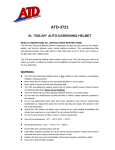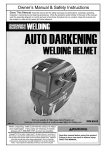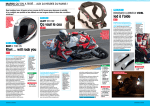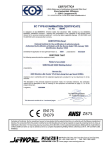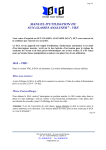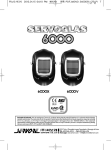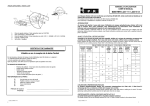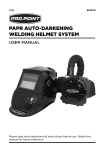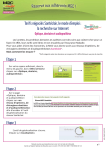Download Téléchargez - Canadian Tire
Transcript
Model: 199-8577-8 199-8578-6 199-8579-4 199-8580-8 Auto-Darkening Welding Helmet Professional Quality Welding Helmet SAFETY WARNINGS – READ BEFORE USING WARNING Read & Understand All Instructions Before Using Auto-darkening welding helmets are designed to protect the eyes and face from sparks, spatter, and harmful radiation under normal welding conditions. An auto-darkening filter automatically changes from a light state to a dark state when an arc is struck, and it returns to the light state when welding stops. Auto-darkening welding helmets come ready for use. The only thing you need to do before you start welding is adjust the position of the headband and select the correct shade number for your application. WARNING • This auto-darkening welding helmet is not suitable for laser welding or for oxyacetylene welding and cutting processes. • Never place this helmet and auto-darkening filter on a hot surface. • Never open or tamper with the auto-darkening filter. • This helmet will not protect against explosive devices or corrosive liquids. • Do not make any modifications to either the filter or the helmet, unless specified in this manual. Do not use replacement parts other than those specified in this manual. Unauthorized modifications and replacement parts will void the warranty and could expose the operator to the risk of personal injury. • Should this helmet not darken upon striking an arc, stop welding immediately and contact your supervisor or your dealer. • Do not immerse the filter in water. • Do not use any solvents on the filter screen or helmet components. • Use only at temperatures: -10 ºC to +55 ºC (14 ºF to 131 ºF). • Storing temperature: -20 ºC to +70 ºC (-4 ºF to 158 ºF). The helmet should be stored in a dry, cool, and dark area with the battery removed when not being used for a long time. • Protect filter from contact with liquid and dirt. • Clean the filter surface regularly; do not use strong cleaning solutions. Always keep the sensors and solar cells clean using a clean lint-free tissue. • Regularly replace cracked / scratched / pitted front cover lens. • Never try to open the filter cartridge. • The materials which may come into contact with the wearer’s skin can cause allergic reactions in some circumstances. • Please install AAA alkaline batteries (2 required) before using this product. • To prevent damage, please remove the batteries when not being used for a long time. WARNING Severe personal injury could occur if the user fails to follow the above mentioned warnings or fails to follow the operating instructions. COMMON PROBLEMS AND REMEDIES • Irregular darkening or dimming Headband has been set unevenly and there is an uneven distance from the eyes to the 1 filter lens. (Reset the headband to even out the distance to the filter.) • Auto-darkening filter does not darken or flickers ① Front cover lens is soiled or damaged. (Change the cover lens.) ② Sensors are soiled. (Clean the sensors surface.) ③ Welding current is too low. (Adjust the sensitivity level to higher.) ④ Check batteries and make sure they are in good condition and installed properly. Also, check battery surfaces and contacts and clean if necessary. • Slow response Operating temperature is too low. (Do not use at temperatures below -10 ºC or 14 ºF.) • Poor vision ① Front/inside cover lens and/or filter is soiled. (Change lens.) ② There is insufficient ambient light. ③ Shade number is incorrectly set. (Reset the shade number.) • Welding helmet slips Headband is not properly adjusted. (Readjust the headband.) WARNING The user must stop using the auto-darkening welding helmet immediately if the above-mentioned problems cannot be corrected. Contact the dealer. INSTRUCTIONS FOR USE WARNING! Before using the helmet for welding, ensure that you have read and understood the safety instructions. • The helmet comes assembled, but before it can be used it must be adjusted to fit the user properly and set up for delay time, sensitivity and shade level. • ADJUSTING THE FIT OF THE HELMET The overall circumference of the headband can be made larger or smaller by rotating the knob on the back of the headband (see adjustment “Y” in Fig. 1). This can be done while wearing the helmet and allows just the right tension to be set to keep the helmet firmly on the head without it being too tight. • If the headband is riding too high or too low on your head, adjust the strap which passes over the top of your head. To do this, release the end of the band by pushing the locking pin out of the hole in the band. Slide the two portions of the band to a greater or lesser width, as required, and push the locking pin through the nearest hole (see adjustment “W” in Fig. 1). • Test the fit of the headband by lifting up and closing down the helmet a few times while wearing it. If the headband moves while tilting, re-adjust it until it is stable. • ADJUSTING THE DISTANCE BETWEEN THE HELMET AND THE FACE Step 1: Undo the block nut (See “T” in Fig. 1) to adjust the distance between the helmet and your face in the down position. Step 2: Loosen the block nut on either side of the helmet and slide it nearer or further from your face (see adjustment “Z” in Fig. 1). It is important that your eyes are both the same distance from the lens. Otherwise the darkening effect may appear uneven. Step 3: Re-tighten the block nut when adjustment is complete. 2 • ADJUSTING VIEW ANGLE POSITION Please see Fig. 2 TOP • SELECTING SHADE LEVEL Select the shade level you require according to the welding process you will use by referring to the “Shade Guide Table” below for settings. Turn the shade control knob on the side of the helmet to the shade number required. W T Z • SELECTING DELAY TIME When welding ceases, the viewing window automatically changes from dark back to light but with a pre-set delay to compensate for any bright afterglow on the workpiece. The delay time/response can be set to “S” (short: 0.1 sec.) or “L” (long: 1.0 sec.). Use the infinitely dial knob on the back of the shade cartridge as needed (see Fig. 4b). It is recommended to use a shorter delay with spot welding applications and a longer delay with applications using higher currents. Longer delays can also be used for low current TIG welding in order to avoid the filter opening when the light path to the sensors is temporarily obstructed by a hand, torch, etc. Definition of the abbreviations found on the filter “L” on the Sensitivity switch means Low “H” on the Sensitivity switch means High “S” on the Delay switch means Short “L” on the Delay switch means Long 3 Z T Y • SELECTING THE GRIND OPTION When the shade knob is turned to the “grind” position, the shade function is turned off allowing a clear view to grind a weld with the helmet providing face protection. Ensure that the shade function is turned back on before welding again (see Fig. 3). • SENSITIVITY The sensitivity can be set to “H” (high) or “L” (low) by using the infinitely dial knob on the back of the shade cartridge. The “MidHigh” setting is the normal setting for everyday use. The maximum sensitivity level is appropriate for low welding current work, TIG, or special applications. Where the operation of the helmet is disturbed by excess ambient light, or another welding machine close by, use the “low” setting (see Fig. 4a). As a simple rule for optimum performance, it is recommended to set sensitivity to the maximum at the beginning and then gradually reduce it, until the filter reacts only to the welding light flash and displays no annoying spurious triggering due to ambient light conditions (direct sun, intensive artificial light, neighbouring welder’s arcs, etc.). Fig. 1 Fig. 2 GRIND 9 13 10 12 11 Fig. 3 Fig. 4a Fig. 4b • TEST Before using, press TEST button to see if the autodarkening filter works well. If the auto-darkening filter does not darken, please replace batteries immediately. Press and hold test button to preview shade selection before welding (see Fig. 5). When released, viewing window will automatically return to the light state (3.5 shade). BATTERIE FAIBLE ESSAI TEST LOW BATTERY Fig. 5 • POWER This ADF cartridge is powered by a solar cell and 2 AAA alkaline batteries. Replace batteries when LOW BATTERY light is lit (see Fig. 5). • You are now ready to use the helmet. The shading may be adjusted during use by resetting potentiometer control. MAINTENANCE • REPLACE THE FRONT COVER LENS. Replace the front cover lens if it is damaged (cracked, scratched, dirty, or pitted). Place your finger or thumb into the recess at the bottom edge of the window and flex the window upwards until it releases from one edge (see Fig. 6). • REPLACE THE INNER COVER LENS. Replace the inner cover lens if it is damaged (cracked, scratched, dirty, or pitted). Place your finger or thumb into the recess at the upper edge of the window and flex lens upwards until it releases from edges of cartridge view window. • The following size lens is applicable to this helmet: Front cover lens: 4 13/32" x 3 37/64" x 1/16" Inside cover lens: 3 25/32" x 1 55/64" x 3/64" • CHANGING THE SHADE CARTRIDGE. (see Fig. 6a & 6b). • INSTALLING NEW CARTRIDGE. Take the new shade cartridge and pass the potentiometer cable under the wire loop before dropping the cartridge into its retaining frame inside the helmet. Press down on the wire loop clip and ensure that the front edge of the loop is properly retained under the retaining lugs as shown in Fig. 6b. • Fasten the potentiometer to the inside of the helmet with the shaft protruding through the hole. Push the shade control knob onto the shaft. • CLEANING. Clean helmet by wiping with a soft cloth. Clean cartridge surfaces regularly. Do not use strong cleaning solutions. Clean sensors and solar cells with methylated spirit and a clean cloth and wipe dry with a lint-free cloth. 4 Fig. 6 Fig. 6a Fig. 6b SPECIFICATIONS Optical Class: 1/1/1/2 Visual field: 3 7/ 8" x 1 3/ 4" Cartridge Size: 4 21/ 64" x 3 1/ 2" x 23/ 64" Arc Sensor: 2 Light State: DIN 3.5 Dark State: DIN 9–13 Shade Control: External, variable shade Power On/Off: Fully automatic Sensitivity Control: Low–high, by infinitely dial knob UV/IR Protection: Up to shade DIN16 at all times Power Supply: Solar-powered with 2 replaceable "AAA" alkaline batteries Switching Time: 1/16,000 s. from light to dark Delay (Dark to Light): 0.1–1.0 s. by infinitely dial knob Low Amperage TIG Rated: ≥ 5 A/DC; ≥ 5 A/AC Grinding: Yes Operating Temperature: -10 °C to +55 °C (14 °F to 131 °F) Storing Temperature: -20 °C to +70 °C (-4 °F to 158 °F) Helmet Material: High impact resistance nylon Total Weight: 500 g Application range: Stick welding (DC & AC); TIG (DC, DC pulse); TIG AC (pulse), excellent low amperage TIG response; MIG/MAG; MIG/MAG pulse; plasma cutting/welding; grinding; not for laser welding or oxyacetylene welding/cutting Standards: ANSI A87.1 and CSA Z94.3 5 PARTS LIST & ASSEMBLY 1. Shell (Welding Mask) 2. Front Cover Lens (4 13/32" x 3 37/64" x 1/16") 3. Auto-Darkening Filter 4. Inside Cover Lens (3 25/32" x 1 55/64" x 3/64") 5. Left Limitation Washer 6. 2 x Angle Adjustable Washer 7. 2 x Washer 8. 2 x Block Nut 9. Right Limitation Washer 10. 2 x Screw 11. Adjustable Headband 12. Sweatband 13. Dial Panel 14. Shade Knob 15. Battery Cover 14 SHADE GUIDE TABLE (NO.1) ARC CURRENT(Amperes) Welding Process 2.5 0.5 1 10 SMAW 80 40 20 15 5 30 60 9 10 100 125 175 275 350 450 225 250 300 400 150 200 500 11 12 MIG(heavy) 10 11 MIG(light) 10 11 TIG,GTAW 11 10 9 10 MAG/CO2 12 12 11 SAW 12 11 8 9 10 11 12 13 14 13 14 14 13 13 11 15 14 13 10 PAC PAW 12 14 13 12 12 13 15 14 15 13 14 15 NOTE: SMAW – Shielded Metal Arc Welding PAC – Plasma Arc Cutting MIG (Heavy) – MIG on Heavy Metals MAG/CO2 – Metal Active Gas TIG, GTAW – Gas Tungsten Arc Welding SAW – Shielded Semi-Automatic Arc Welding PAW – Plasma Arc Welding MIG (Light) – MIG on Light Alloys WARNING This Mastercraft Maximum product carries a one-year warranty against defects in workmanship and materials. This product is not guaranteed against wear or breakage due to misuse and/or abuse. 6 Modèle: 199-8577-8 199-8578-6 199-8579-4 199-8580-8 Masque de soudeur photochromique 7 Masque de soudeur de qualité professionnelle CONSIGNES DE SÉCURITÉ – À LIRE AVANT D’UTILISER AVERTISSEMENT Lisez attentivement toutes les instructions avant d’utiliser le masque Le masque de soudeur photochromique protège les yeux et le visage contre les étincelles, les éclaboussures et les rayons nocifs dans des conditions de soudage normales. Sa lentille photochromique automatiquement de l’état clair à l’état sombre lorsque vous amorcez un arc et revient à l’état clair lorsque vous arrêtez de souder. Le masque de soudeur photochromique est prêt à utiliser dès l’achat. Avant de commencer à souder, vous n’avez qu’à ajuster la position du serre-tête et à choisir le numéro de teinte qui convient au travail à effectuer. AVERTISSEMENT • Ce masque de soudeur photochromique n’est pas conçu pour le soudage au laser ni pour le soudage et le coupage oxyacétylénique. • Ne posez jamais ce masque ni sa lentille photochromique sur une surface très chaude. • Ne tentez jamais d'ouvrir ou d’altérer la lentille photochromique. • Ce masque ne protège pas contre les engins explosifs ou les liquides corrosifs. • N’apportez aucune modification à la lentille ni au masque, à moins que le présent guide indique de le faire. N’utilisez aucune pièce de rechange autre que celles mentionnées dans le présent guide. Les modifications et l’utilisation de pièces de rechange non approuvées annuleront la garantie et exposeront l’utilisateur à des risques de blessures. • Si le masque ne s’assombrit pas dès l’amorçage d’un arc, arrêtez de souder immédiatement et communiquez avec votre superviseur ou votre détaillant. • N’immergez pas la lentille. • N’appliquez aucun solvant sur la lentille ou les composants du masque. • Utilisez le masque uniquement à des températures de -10 °C à 55 °C (14 °F à 131 °F). • Température de rangement : -20 °C à 70 °C (-4 °F à 158 °F). Lorsque vous n’utiliserez pas le masque pendant une longue période, vous devriez le ranger dans un endroit sec, frais et sombre et en retirer la pile. • Évitez que la lentille entre en contact avec les liquides et la saleté. • Nettoyez régulièrement la surface de la lentille; n’utilisez aucune solution nettoyante puissante. Nettoyez toujours les détecteurs et les piles solaires à l’aide d’un linge non pelucheux propre. • Remplacez immédiatement la lentille de protection avant si elle est fissurée, égratignée ou piquée. • Ne tentez jamais d’ouvrir la cartouche filtrante. • Dans certains cas, les matériaux qui entrent en contact avec la peau de l’utilisateur peuvent causer des réactions allergiques. • Veuillez insérer 2 piles alcalines AAA avant d’utiliser cet article. • Si vous prévoyez ne pas utiliser le masque pendant une longue période, retirez-en les piles afin d’éviter de l’endommager. 8 AVERTISSEMENT L’utilisateur pourrait subir de graves blessures s’il ne respecte pas les avertissements susmentionnés ou s’il ne suit pas le mode d’emploi. PROBLÈMES COURANTS ET SOLUTIONS • Assombrissement irrégulier Le serre-tête est mal positionné, et la distance entre les yeux et la lentille filtrante est irrégulière (repositionnez le serre-tête pour réduire la différence de distance par rapport à la lentille). • La lentille photochromique ne s’assombrit pas ou vacille ① La lentille protectrice avant est souillée ou endommagée (remplacez la lentille protectrice). ② Les détecteurs sont souillés (nettoyez la surface des détecteurs). ③ Le courant de soudage est trop faible (réglez la sensibilité au niveau le plus élevé). ④ Assurez-vous que les piles sont en bon état et qu’elles sont bien installées. Vérifiez également les surfaces et les bornes des piles et nettoyez-les au besoin. • Réaction lente La température d’utilisation est trop basse (n’utilisez pas le masque à une température inférieure à -10 °C ou 14 °F). • Mauvaise vision ① La lentille protectrice avant ou intérieure ou la lentille filtrante est souillée (remplacez la lentille). ② La lumière ambiante est insuffisante. ③ Le numéro de teinte est mal réglé (réglez le numéro de teinte correctement). • Le masque de soudeur glisse Le serre-tête est mal ajusté (réajustez le serre-tête). AVERTISSEMENT Si vous ne pouvez remédier aux problèmes ci-dessus, vous devez cesser immédiatement d’utiliser le masque de soudeur photochromique. Communiquez avec le détaillant. MODE D’EMPLOI AVERTISSEMENT! Avant d’utiliser le masque pour souder, assurez-vous d’avoir lu attentivement les consignes de sécurité. • Le masque est assemblé en usine, mais avant de pouvoir l’utiliser, vous devez ajuster convenablement le serre-tête et régler le délai, la sensibilité et le degré de teinte. • AJUSTEMENT DU MASQUE Vous pouvez agrandir ou raccourcir la circonférence du serre-tête en tournant le bouton situé à l’arrière du serre-tête (voir l’ajustement « Y » à la fig. 1). Cela s’effectue pendant que vous portez le masque et permet un réglage parfait de la tension, c’est-à-dire que le masque est ni trop lâche ni trop serré. • Si le serre-tête remonte ou redescend trop, ajustez le harnais qui passe sur le dessus de votre tête. Pour ce faire, dégagez l’extrémité du serre-tête en poussant la goupille hors du trou percé dans le serre-tête. Faites glisser les deux portions du serre-tête, au besoin, pour en agrandir ou en raccourcir la circonférence et poussez la goupille dans le trou le plus près (voir l’ajustement « W » à la fig. 1). 9 • Vérifiez l’ajustement du serre-tête en relevant et en abaissant le masque à quelques reprises pendant que vous le portez. Si le serretête bouge, réajustez-le jusqu’à ce qu’il soit stable. • RÉGLAGE DE LA DISTANCE ENTRE LE MASQUE ET LE VISAGE Étape 1 : Débloquez le bouton de tension (voir « T » à la fig. 1) pour ajuster la distance verticale entre le masque et votre visage. Étape 2 : Desserrez le bouton de tension gauche ou droit du masque et éloignez ou rapprochez celui-ci de votre visage en le faisant glisser (voir l’ajustement « Z » à la fig. 1). Il est important que chacun vos deux yeux soient à égale distance de la lentille. Sinon, l’effet d’assombrissement pourrait vous paraître irrégulier. Étape 3 : Resserrez le bouton de tension lorsque le réglage est terminé. HAUT W T Z fig. 1 Z T Y • RÉGLAGE DE L’ANGLE DE VISION Voir la fig. 2 fig. 2 • CHOIX DU DEGRÉ DE TEINTE GRIND Choisissez le degré de teinte selon le procédé que vous utiliserez. (Meulage) Consultez la table des teintes à la fin du guide pour connaître les degrés de teinte. Tournez le régulateur de teinte, situé sur le côté du 13 masque, jusqu’au numéro de teinte qu’il vous faut. • ANNULATION DE LA TEINTE POUR LE MEULAGE Lorsque le régulateur de teinte est à la position de meulage (GRIND), la lentille ne s’assombrit pas. Vous pouvez ainsi bien voir la soudure que vous meulez tout en ayant le visage protégé. Avant de recommencer à souder, assurez-vous que la fonction d’assombrissement a bien été activée (voir la fig. 3). • SENSIBILITÉ La sensibilité peut être réglée à « H » (haute) ou « B » (basse) au moyen du bouton de sélection situé à l’arrière de la cartouche filtrante. Le réglage moyen-haut (Mid-High) est recommandé pour l’utilisation quotidienne. Le réglage de sensibilité maximal convient pour le soudage à faible courant, le soudage TIG ou les applications spéciales. Lorsque la lumière ambiante excessive ou un autre appareil de soudage se trouvant à proximité nuit au fonctionnement du masque, utilisez le réglage bas (voir la fig. 4). Pour optimiser le rendement, il est généralement recommandé de d’abord régler la sensibilité au maximum, puis de la diminuer graduellement, jusqu’à ce que la lentille filtrante réagisse uniquement au coup d’arc et qu’il n’y ait aucun déclenchement indésirable attribuable aux conditions d’éclairage (lumière directe du soleil, lumière artificielle intensive, arcs de soudage voisins, etc.). 10 9 10 12 11 fig. 3 fig. 4a fig. 4b • CHOIX DU DÉLAI Lorsque vous avez terminé de souder, la lentille passe automatiquement de l’état sombre à l’état clair selon un délai prédéterminé pour compenser toute incandescence résiduelle provenant de la pièce à travailler. Le délai/la réaction peut être réglé(e) à « C » (court : 0,1 s) ou « L » (long : 1,0 s). Au besoin, utilisez le bouton de sélection situé à l’arrière de la cartouche filtrante (voir la fig. 4b). Il est recommandé d’opter pour un délai plus court lorsque vous effectuez des soudures par points et pour un délai plus long lorsque vous soudez à courant élevé. Un délai plus long convient également au soudage TIG à faible courant, car cela permet d’éviter que la lentille s’ouvre lorsque les détecteurs d’arc sont temporairement obstrués, notamment par une main ou un chalumeau, et ne peuvent capter la lumière. Définitions des abréviations sur la cartouche filtrante « B » sur le bouton de sélection Sensibilité signifie « Bas » « H » sur le bouton de sélection Sensibilité signifie « Haut » « C » sur le bouton de sélection Sensibilité signifie « Court » « L » sur le bouton de sélection Sensibilité signifie « Long » BATTERIE FAIBLE ESSAI TEST LOW BATTERY fig. 5 • ESSAI Avant d’utiliser le masque, appuyez sur le bouton d’essai (TEST) pour vérifier si la lentille photochromique fonctionne bien; si elle ne s’assombrit pas, remplacez les piles immédiatement. Maintenez enfoncé le bouton d’essai pour avoir un aperçu de la teinte choisie avant de commencer à souder (voir la fig. 5). Lorsque vous relâchez le bouton, la lentille revient automatiquement à l’état clair (teinte 3,5). • ALIMENTATION Cette cartouche filtrante est alimentée par une pile solaire et deux piles alcalines AAA. Remplacez les piles lorsque l’indicateur de piles faibles (LOW BATTERY) est allumé (voir la fig. 5). • Vous êtes maintenant prêt à utiliser le masque. Vous pouvez régler la teinte pendant l’utilisation en réinitialisant le potentiomètre. 11 ENTRETIEN • REMPLACEMENT DE LA LENTILLE DE PROTECTION AVANT Remplacez la lentille de protection avant si elle est endommagée (c.-à-d. fissurée, égratignée, souillée ou piquée). Placez votre pouce ou un autre doigt dans la cavité se trouvant à l’extrémité inférieure de la lentille et repliez celle-ci vers le haut jusqu’à ce qu’elle se dégage d’un côté (voir la fig. 6). • REMPLACEMENT DE LA LENTILLE DE PROTECTION INTÉRIEURE Remplacez la lentille de protection intérieure si elle est endommagée (c.-à-d. fissurée, égratignée, souillée ou piquée). Placez votre pouce ou un autre doigt dans la cavité se trouvant sur la partie supérieure de la lentille et repliez celle-ci vers le haut jusqu'à ce qu'elle se dégage des côtés de la cartouche. Dimensions des lentilles de ce masque: Lentille avant : 4 13/32 x 3 37/64 x 1/16 po Lentille intérieure : 3 25/32 x 1 55/64 x 3/64 po • REMPLACEMENT DE LA CARTOUCHE FILTRANTE (voir les fig. 6a et 6b) • INSTALLATION D’UNE NOUVELLE CARTOUCHE Prenez la nouvelle cartouche filtrante et passez le câble du potentiomètre sous l’anse métallique avant de déposer la cartouche dans son logement à l’intérieur du masque. Enfoncez la fixation et assurez-vous que l’extrémité avant de l’anse est bien fixée sous les languettes de retenue comme l’illustre la fig. 6b. • Fixez le potentiomètre à l’intérieur du masque en faisant dépasser l’axe par le trou. Appuyez le régulateur de teinte contre l’axe. • NETTOYAGE Nettoyez le masque en l’essuyant à l’aide d’un linge doux. Nettoyez régulièrement les surfaces de la cartouche. N’utilisez aucune solution nettoyante puissante. Nettoyez les détecteurs et les piles solaires à l’aide d’alcool dénaturé et d’un linge propre et essuyez-les complètement à l’aide d’un linge non pelucheux propre. fig. 6 fig. 6a 12 fig. 6b FICHE TECHNIQUE Classe optique : 1/1/1/2 Champ visuel : 3 7/ 8 po x 1 7/ 8 po Dimensions de la cartouche : 4 21/ 64 po x 3 1/ 2 po x 23/ 64 po Détecteurs d’arc : 2 État clair : DIN 3.5 État sombre : DIN 9-13 Régulateur de teinte : Externe, teinte variable Mise en marche / Arrêt : Entièrement automatique Réglage de la sensibilité : De bas à haut, au moyen du bouton de sélection Protection UV/IR : Jusqu’à la teinte DIN16 en tout temps Alimentation : Pile solaire et 2 piles alcalines AAA rechargeables Temps de transition : 1/16 000 s, de clair à sombre Délai (de clair à sombre) : 0,1 à 1,0 s, au moyen du bouton de sélection Capacité nominale TIG à faible intensité : ≥ 5 A, CC; ≥ 5 A, CA Meulage : Oui Température d’utilisation : -10 °C à 55 °C (14 °F à 131 °F) Température de rangement : -20 °C à 70 °C (-4 °F à 158 °F) Matériau : Nylon à résistance élevée aux chocs Poids total : 500 g Applications : Soudage à l’arc (CC et CA), TIG (CC, impulsion de CC), TIG (impulsion de CA), excellente réaction au soudage TIG à faible intensité, MIG/MAG, MIG/MAG à impulsion, soudage et coupage au plasma, meulage, non conçu pour le soudage au laser ni pour le soudage ou le coupage oxyacétylénique Normes : ANSI Z87.1 et CSA Z94.3 13 LISTE DES PIÈCES ET ASSEMBLAGE 1. Coque (masque de soudeur) 2. Lentille de protection avant (4 13/32" x 3 37/64" x 1/16") 3. Lentille photochromique 4. Lentille de protection intérieure (3 25/32" x 1 55/64" x 3/64") 5. Rondelle de retenue gauche 6. Rondelles angulaires ajustables (2) 7. Rondelles (2) 14 8. Boutons de tension (2) 9. Rondelle de retenue droite 10. Vis (2) 11. Serre-tête ajustable 12. Bandeau absorbant 13. Bouton de sélection 14. Régulateur de teinte 15. Couvercle des piles REMARQUE : SMAW – Shielded Metal Arc Welding (Soudage à l’arc avec électrode enrobée) MIG (lourds) – Soudage MIG sur métaux lourds MIG (légers) – Soudage MIG sur métaux légers TIG, GTAW – Gas Tungsten Arc Welding (Soudage à l’électrode de tungstène) MAG/CO2 - Metal Active Gas (Soudage à l’arc en atmosphère active) SAW – Shielded Semi-Automatic Arc Welding (Soudage à l’arc semi-automatique) PAC – Plasma Arc Cutting (Coupage au plasma) PAW – Plasma Arc Welding (Soudage au plasma) GARANTIE Garantie : un (1) an contre les défauts de fabrication et de matériau(x). Exclusion : usure ou bris causés par un usage abusif ou inapproprié. 14
















